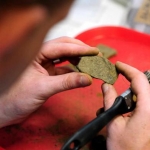Art in the News - 2015
Read the latest arts news
On November 3, voters in Cuyahoga County in Ohio will be presented with Issue 8—a ballot initiative which will seek to renew a penny-and-a-half sales tax on cigarette sales that directly benefits local arts organizations for an additional 10 years. If not renewed, the levy will expire on January 21, 2017. Originally approved by voters in 2006, the sales tax created the Cuyahoga Arts & Culture which has since distributed more than $125 million to 300 arts and culture organizations throughout Cuyahoga County.
New Jersey’s Senate State Government, Wagering, Tourism & Historic Preservation Committee approved a bill that would provide tax breaks for top-billed entertainers who perform at least four shows in Atlantic City's tourism district. S2721 would exempt out-of-state performers from state income taxes on earnings from performances in Atlantic City or any others in New Jersey during the same calendar year.
Illinois Governor Bruce Rauner closed all state museums on September 30; he cited the closures as “part of his efforts to manage state finances” while a budget deal with Democratic Legislature is still being negotiated. Chairman of the State Museum Board Guerry Suggs decried the governor’s actions and said that the closure of the 138-year-old museum in Springfield and its four satellite facilities will only save the state less than $400,000 of the Illinois' projected $5 billion budget deficit.
The Lincoln Center for the Performing Arts has current job openings for veterans, according to Ed Walsh, Veterans and Community Relations Manager. As an expression of thanks to those who have served our country, the Lincoln Center Veterans initiative offers attendance opportunities, discount tours, special events, and employment opportunities to active duty personnel and veterans of th
The Veterans Curation Program (VCP) is a paid training and employment opportunity that provides veterans with tangible work skills and experience through the rehabilitation of archaeological collections owned by the US Army Corps of Engineers. The Veterans Curation Program is seeking OEF and OIF veterans, veterans with service-connected disabilities, and other recently separated veterans for a paid training program to work as archaeological laboratory technicians at facilities in Alexandria, VA, Augusta, GA, and St. Louis, MO for the upcoming session, scheduled to begin in early November 2015.
A committee of the Minneapolis City Council unanimously passed a proposal that would set aside a designated percentage of the city’s net debt bond for public art funding. The proposed ordinance, which was passed on a 5-0 vote, would enforce a minimum amount of funding for maintaining and building new public artworks each year. The minimum amount for public art would be equal to 1.5% of the debt the city takes on for public projects. The proposed ordinance will now be submitted to a vote by the full City Council.
The rising cost of housing and work spaces is a problem that is rapidly threatening arts professionals. In San Francisco, the San Francisco Arts Commission conducted a survey which polled nearly 600 sculptors, painters, musicians, writers, filmmakers and painters. The results showed that 70% said they had been displaced or were being displaced from their homes, workplaces, or both; 28% reported that they were at risk of being displaced imminently.
Minnesota has been named the nation’s leader in using arts and culture to revitalize rural communities. Three rural towns—Fergus Falls, Lanesboro, Wykoff—are receiving funding and program assistance from national organizations such as the National Endowment for the Arts, ArtPlace America, and the Dreamery Rural Arts Initiative respectively.
As part of its recently released Blueprint for Collective Action for the Arts initiative, Cincinnati-based United Arts Fund, ArtsWave, has announced its’ new strategy will allocate funding based on five community goals.
The City of Austin, highly regarded for its culture of live music, released the findings of its first music census in June 2015. The census reported that over 68 percent of Austin musicians made less than $10,000 annually and that 20 percent were living below poverty levels. In addition, the city found that respected music venues were closing due in part to rising rental costs.








